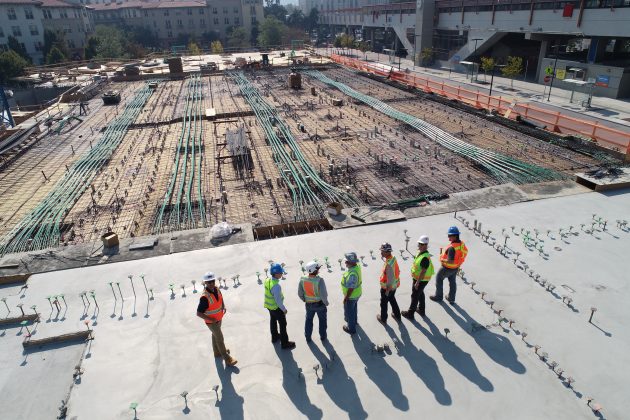
Technology innovations in manufacturing that have developed the construction industry
by Andrew Richardson, NBS

Self-healing concrete, bioplastics and renewable energy are all manufacturing industry innovations that have helped the construction industry advance and develop.

Technology Innovations in Manufacturing that have Developed the Construction Industry
The most innovative current solutions in the manufacturing industry have helped to develop construction projects as well. Advanced technologies have come from new material, energy supply, and design approach perspectives. Advances in the sector also come from manufacturer marketing which is essential for growth and innovation.
The material world
Where better to start than the materials that help the world of manufacturing flourish, particularly in the world of construction? Using these materials can help your manufacturing business grow by showing new clients that you’re ahead of the competition. The following materials are currently some of the most innovative products on the market:
Self-healing concrete
Used across the building industry, self-healing concrete quite literally helps to paper over the cracks. A concrete with the ability to self-heal is a welcome addition to industries like housing and commercial property.
Where does the magic come from? Well, concrete is mixed with Bacillus bacteria before pouring, which helps create limestone. The limestone then fills in any cracks that form. The bacteria can lay dormant for over 200 years – making this a long-term solution and not a short-term fix.
Using this product in your manufacturing business has a variety of marketing uses. Clients and customers will invest in products that offer longevity and low maintenance. Additionally, self-healing concrete can aid client’s sustainable strategies. One consumer study found that 65 per cent of people would pay up to 20 per cent more on eco-friendly products. Aligning your manufacturing business with sustainability and longevity can help promote your products.
Bioplastic
Plastic is one of the most contaminant elements in the world due to its slow process of biodegradation. Step forward bioplastic, which is made from algae and other renewable biomass resources.
With a lower degrading threshold, it works as a fantastic green alternative to plastic made with fossil fuels. Its sustainable personality is well-suited for use in cladding, structural elements, and other architecture-strengthening structures.
The demand for reduced plastics in manufacturing is high. 60 per cent of consumers say they ‘need help’ in reducing their plastic use. Using bioplastic is an innovative approach to attract consumers and clients who want to achieve an eco-friendlier business or lifestyle.
Clean, renewable energy
According to statistics in 2019, building and construction accounted for 39 per cent of the world’s greenhouse gas emissions – for suppliers or manufacturers, there’s an opportunity here to create innovative solutions that can have a positive impact on the construction industry.
Today, businesses are competing in terms of their clean energy commitments. While most businesses are dedicated to their sustainable strategies, it’s also a great marketing tool. Some clients, in order to achieve their own environmental targets, may only approach manufacturers that meet their own ethical standard. Clean energy is one manufacturing sector that can provide solutions to these businesses.
Design by innovative committee
For innovation to take place in the supply world, creative design is a necessity. For a glimpse into the future, you only need to look at the Construction Innovation Hub to see what progress is being made from a manufacturing point of view.
Through the Platform Design Programme, the aim is to:
- Identify, develop, and deploy projects at scale
- Design integrated, manufactured components that will adhere to new standards
- Create a ‘rulebook’ that will support wider adoption and provide guidance on how the system can support delivery
- Make available the new standards and rulebook to all businesses in the UK, removing barriers for SMEs and new entrants
Looking to the future
With the pandemic pushing the industry into a complete re-think, it will be interesting to see what happens next when it comes to new ideas, new ways of thinking, and innovation. It’s likely that we’ll see an even greater focus on a greener future – which is something that should be applauded and encouraged.